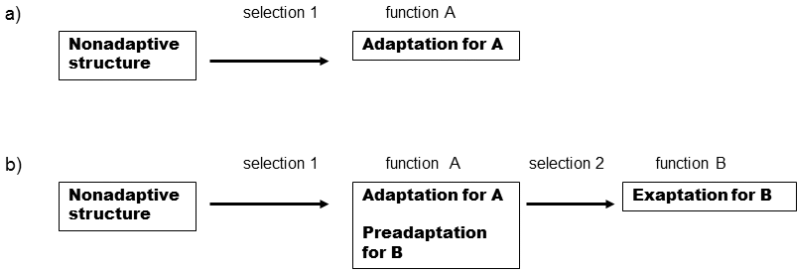I.7.1 Preadaptations are biological structures or patterns of behaviour that developed in a different selection context than that in which they later became advantageous.
The formation of a great many adaptive traits through the action of natural selection was far from straightforward. A great many biological structures or patterns of behaviour were formed as a consequence of completely different selection pressures than would follow from their contemporary biological functions and, in some cases, the reason for the formation of the original structure was not selection at all. In this case, evolutionary biologists speak about the formation of the relevant structures on the basis of already existing preadaptation and the relevant traits are mostly not termed adaptation but rather exaptation (Gould & Vrba 1982) (Fig. I.12).

Fig. I.12 Adaptation and exaptation. Complex biological structures that currently fill a vital function can be divided into two categories, adaptation and exaptation. Adaptation encompasses structures that fulfill the same function from the very beginning and were formed and developed as a consequence of the action of the same selection pressure as is acting on them at the present time (a). In contrast, the category of exaptation includes structures that currently fulfill a different biological function than they fulfilled in the past and that thus originally formed and developed as a consequence of the action of a different selection pressure than that acting on them at the present time (b). However, the separation of structures into adaptation and exaptation is relative; a certain structure can simultaneously fulfill both the original and a new function, so that it can be simultaneously adaptation from the standpoint of function A and exaptation from the standpoint of function B. Adaptation for function A, which becomes the basis for the formation of exaptation from the standpoint of function B, is mostly denoted by the older term preadaptation for function B. A number of biologists try to avoid this term. It could create the impression in the uninstructed reader or student that evolution is capable of planning ahead and that complex structures can thus be formed during its progress that will become useful for their bearers only in the future.
The wings of insects apparently developed from structures that originally served the processes of respiration or, according to another theory, for thermoregulation, and thus they emerged and were formed over a long time through the action of selective pressures following from this original function. Similarly, bird feathers emerged and developed for a long time as an organ of thermoregulation in some groups of reptiles and, only after attaining a certain stage in development, could also begin to fulfill an aerodynamic function and their further evolution could begin to be affected by selective pressures following from the function of wings during flight. The development of the human brain towards an organ of abstract thinking was, according to some concepts, started by the movement of primates into the branches of trees and the selective advantageous of the formation and development of an organ permitting orientation in this complicated three-dimensional space.
The existence of exaptation must always be taken into account in considerations on the evolution of any biological structures. It is always necessary to consider, not only the contemporary biological function of a particular structure, but also any functions that this structure or a homologous structure could have performed in the evolutionary past and that could definitively affect the processes of its evolutionary formation.
